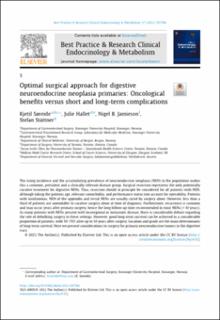Optimal surgical approach for digestive neuroendocrine neoplasia primaries: Oncological benefits versus short and long-term complications
Journal article, Peer reviewed
Published version

Åpne
Permanent lenke
https://hdl.handle.net/11250/3121292Utgivelsesdato
2023Metadata
Vis full innførselSamlinger
- Department of Clinical Medicine [2044]
- Registrations from Cristin [9489]
Originalversjon
Baillière's Best Practice & Research. Clinical Endocrinology & Metabolism. 2023, 37 (5), 101786. 10.1016/j.beem.2023.101786Sammendrag
The rising incidence and the accumulating prevalence of neuroendocrine neoplasia (NEN) in the population makes this a common, prevalent and a clinically relevant disease group. Surgical resection represents the only potentially curative treatment for digestive NENs. Thus, resection should in principle be considered for all patients with NEN, although taking the patients age, relevant comorbidity, and performance status into account for operability. Patients with insulinomas, NEN of the appendix and rectal NENs are usually cured by surgery alone. However, less than a third of patients are amendable to curative surgery alone at time of diagnosis. Furthermore, recurrence is common and may occur years after primary surgery, hence the long follow-up time recommended in most NENs (>10 years). As many patients with NENs present with locoregional or metastatic disease, there is considerable debate regarding the role of debulking surgery in these settings. However, good long-term survival can be achieved in a considerable proportion of patients, with 50–70% alive up to 10 years after surgery. Location and grade are the main determinants of long-term survival. Here we present considerations to surgery for primary neuroendocrine tumors in the digestive tract.
